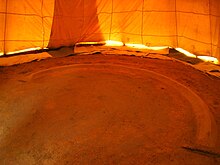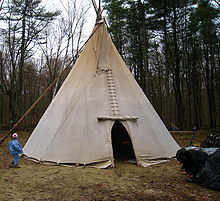From Wikipedia, the free encyclopedia
The Native American Church (NAC), also known as Peyotism and Peyote Religion, is a Native American religion characterized by mixed traditional and Protestant beliefs and by sacramental use of the entheogen peyote. The religion originated in the U.S. state ofOklahoma in the late nineteenth century after peyote was introduced to the southern Great Plains from Mexico.[1][2][3] Today it is the most widespread indigenous religion among Native Americans in the United States, Canada, and Mexico, with an estimated 250,000 adherents as of the late twentieth century.[4][5][6][7]
Contents
[hide]History of the peyote religion[edit]
Peyote use originated in pre-Columbian Mexico as a medicine and a means of mystic revelation. The tradition spread north to tribes in the United States in the mid-nineteenth century and acquired its present form around 1885 and thereafter began its wider spread.[3][7]
The two current, major NAC chapters in the United States showcase this dichotomy: the Native American Church of the United States, the original umbrella incorporated church birthed in 1918 from which many other chapters are tied to, allows non-natives to participate, in regulation with state law. On the other hand, the Native American Church of North America, incorporated much later in the 1950s, only allows Native Americans with a 1/4 native blood quantum and CIB certificate to participate (Omer Stewart - Peyote Religion).
Development of the movement[edit]
| This article appears to contradict the article Quanah_Parker. (April 2009) |
Quanah Parker, along with other prominent roadmen, was influential in the adoption of the Native American Church by tribal entities in the United States. Even though historically ceremonies are much older, the NAC movement started generally in the 1880s and was formally incorporated in 1918 in Oklahoma. The genesis of modern NAC ceremonies have deep roots in both Mexican and Native American culture and ritual, due to the natural locality of peyote and the dissemination by Parker to theComanche and other plains tribes located in Indian Territory.[8][9]
Though there are many variations, the main two ceremonial styles of the NAC are the "half moon" fireplace and the "cross fire" fireplace. Parker learned the "half moon" style of the peyote ceremony from the Lipan Apache leader Chevato. The Lipan Apache learned the ceremony from the Comecrudo tribe of Southern Texas (Peyote Religion by Omer Stewart). The "half moon" fireplace hallmarks include the use of tobacco throughout, with very little to no use of the Bible in the ceremony. This does vary tribe-to-tribe. The "cross fire" ceremony (originally called the "Big Moon" ceremony) became prevalent in Oklahoma (initially among the Kiowa) due to the influence of John Wilson, a Caddo man who traveled extensively around the same time as Parker during the early days of the Native American Church movement. The "cross fire" ceremony has elements that separate it strongly from the "half moon". Usually, there is no tobacco used in the meeting and the use of the Bible is used extensively. Therefore, it is a merger of both indigenous ritual and Christian doctrine and belief.
United States law[edit]
As a result of the U.S. Supreme Court decision in Employment Division, Department of Human Resources of Oregon v. Smith, 494 U.S. 872 (1990), which, among other things, put the legal use of peyote by American Indians into uncertainty and potential legal jeopardy, Congress passed an amendment to the American Indian Religious Freedom Act of 1978 (42 U.S.C. § 1996), i.e., the American Indian Religious Freedom Act Amendments of 1994 (42 U.S.C. § 1996a), pertinent excerpts of which are given below:
Instruments[edit]
Native American Church instruments used in the peyote ceremony are as follows:
- The peyote gourd rattle (also used in the Gourd Dance ceremony) consists of a hard wooden stick, with a vegetable gourd cut in half and affixed to a wooden or other hard stopper. It has a horsehair top with usually intricate threadwork that is removable at top. Leather fringe tassel affixed to the bottom of the gourd stick. It can be beaded or carved depending on the artist's taste. Finally, inside of the gourd is filled with stones, pebbles or other material to produce a special sound. This rattle is used to sing peyote songsduring the NAC ceremony.
- The water drum is an iron kettle, with ears cut off, that is tied down with a deer, caribou, or other animal hide. It is tied down with stones or marbles along a certain formation along the side. It is filled with water halfway and produces a special, deep sound when played with a drumstick. It is played by the water drummer during the ceremony while the singer sings songs with a peyote rattle. The tempo played by the drum is usually rapid and quick.
- The peyote drum stick is a single hard wooden stick used to play the drum during the ceremony. It is usually made from dense wood to produce a more satisfactory sound when played with the water drum.
- The peyote staff is a wooden staff that is passed around with the water drum and peyote rattle. It is representative of holy god and is held up right during the ceremony. The staff is usually beaded or carved to match the gourd. Like the peyote rattle, it usually has a horsehair top affixed and removable.
See also[edit]
- Employment Division v. Smith
- Freedom of thought
- Hair drop, Native American Church regalia
- Indigenous peoples of the Americas
- The red road
References[edit]
- ^ http://www.facstaff.bucknell.edu/jms089/Z-Unpublished%20Work/Shields-Christ%20&%20Cactus.pdf
- ^ Catherine Beyer. "Peyote and the Native American Church". About.com Religion & Spirituality. Retrieved 5 March 2015.
- ^ a b "Native American Church". Encyclopedia Britannica. Retrieved 5 March 2015.
- ^ "Native American Church". Retrieved 5 March 2015.
- ^ "World Religions & Spirituality - Native American Church". Retrieved 5 March 2015.
- ^ "University of Virginia Library". Religiousmovements.lib.virginia.edu. 2006-09-07. Retrieved 2011-07-09.
- ^ a b "'A Brief History of the Native American Church'". CSP. 1996.
- ^ Stewart OC. 1989. Peyote Religion: A History. Norman, OK: University of Oklahoma Press. ISBN 0-8061-2457-1.
- ^ Alice Lee Marriott, Carol K. Rachlin, Peyote: An Account of the Origins and Growth of the Peyote Religion, New York: Thomas Y. Crowell Co. (1971), 111pgs.
Bibliography[edit]
- Hayward, Robert. The Thirteenth Step: Ancient Solutions to the Contemporary Problems of Alcoholism and Addiction using the Timeless Wisdom of The Native American Church Ceremony. Native Son Publishers Inc., 2011. ISBN 0983638403. -- Describes the Native American Church Ceremony.
External links[edit]
| Wikimedia Commons has media related to Native American Church. |
- Listing of Native American Churches
- Native American Churches
- American Ethnography – The use of Peyote by the Carrizo and Lipan Apache tribes
- Native American Church, Oklahoma Historical Society
- "Native American Church, Encyclopedia of the Great Plains







No comments:
Post a Comment